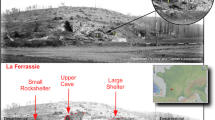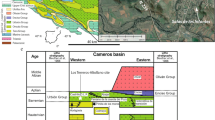Abstract
The Machari Formation ranges from the “upper Series 3” (Middle Cambrian) to Furongian (Upper Cambrian) in the Yeongwol area, Korea. It has been known to yield relatively diverse invertebrate fossils. Particularly, the trilobite biozones of the formation have been well defined. On the other hand, little has hitherto been studied on conodont microfossils for the formation. This paper reports a diverse and well-preserved protoconodonts and paraconodonts of Series 3 from the formation in the Eodungol Section, exposed along a southern mountain trail of Mt. Sambangsan, Yeongwol, Korea. Five of the 13 samples collected for conodont contain a rich protoconodont and paraconodont assemblage and numerous shelly fossils including trilobites, brachiopods, sponge spicules, hyolithids, and incertae sedis. Sample Eo 5 is extremely fossiliferous (465 elements, 96.5% of total collection), and the most abundant species was Phakelodus elongatus (236 elements, 62% of the Eo 5 collection). The preservation is relatively good, but some specimens are corroded and fragmentary. Some of the protoconodonts are exfoliated. Relatively larger ones were commonly preserved as phosphatized internal molds, particularly in specimens of Furnishina bigeminata, Furnishina leei n. sp., Muellerodus pomeranensis, Nogamiconus sinensis, and westergaardodids. Phakelodids were commonly preserved as clusters. Among 20 species referable to nine genera, Furnishina bigeminata, Furnishina leei n. sp., Nogamiconus sinensis, Huayuanodontus tricornis, Proscandodus obliquus, and Westergaardodina grandidens were previously undescribed species in Korea. This assemblage is named herein as the Westergaardodina matsushitai Zone, which is a new biozonal name replacing the old one, i.e., Gapparodus bisulcatus-Westergaardodina matsushitai-Westergaardodina moessebergensis Assemblage. The W. matsushitai Zone corresponds to the Lejopyge armata trilobite Zone and is well correlated with the upper Series 3 conodont biozones of the Westergaardodina matsushitai-Westergaardodina grandidens Zone of South China and the Westergaardodina matsushitai Zone of North China, respectively. The present data allow a useful correlation to China and Baltica in relation to new subdivision of the Cambrian. Furnishina leei n. sp. is newly described.
Similar content being viewed by others
References Cited
Abaimova, G. P., 1978. Late Cambrian Conodonts of Central Kazakhstan. Paleontologicheskii Zhurnal, 4: 77–87
An, T. X., 1981. Recent Progress in Cambrian and Ordovician Conodont Biostratigraphy of China. Geological Society of America Special Paper, 187: 209–225
An, T. X., 1982. Study on the Cambrian Conodonts from North and Northeast China. Science Reports, Institute of Geoscience, University of Tsukuba, Section B, 3: 113–159
An, T. X., Zhang, F., Xiang, W., et al., 1983. The Conodonts of North China and Adjacent Regions. Science Press, Beijing. 223 (in Chinese with English Abstract)
Bagnoli, G., Qi, Y. P., Wang, Z. H., 2008. Conodonts from the Global Stratotype Section for the Base of the Guzhangian Stage (Cambrian) at Luoyixi, Hunan, South China. Palaeoworld, 17(2): 108–114
Bednarczyk, W., 1979. Upper Cambrian to Lower Ordovician Conodonts of Lena Elevation, NW Poland, and Their Stratigraphic Significance. Acta Geologica Polonica, 29: 409–442
Chen, J. Y., Gong, W. L., 1986. Conodonts. In: Chen, J. Y., ed., Aspects of Cambrian-Ordovician Boundary in Dayangcha, China. Prospect Publishing House, Beijing. 93–223
Choi, D. K., 1998. The Yongwol Group (Cambrian-Ordovician) Redefined—A Proposal for the Stratigraphic Nomenclature of the Choson Supergroup. Geosciences Journal, 2: 220–235
Choi, D. K., Kim, E. Y., Lee, J. G., 2008. Upper Cambrian Trilobites from the Machari Formation, Yongwol, Korea. Geobios, 41: 183–204
Choi, D. K., Lee, J. G., 1995. Occurrence of Glyptagnostus Stolidotus Öpik, 1961 (Trilobita, Late Cambrian) in the Machari Formation of Korea. Journal of Paleontology, 69(3): 590–594
Choi, D. K., Lee, J. G., Sheen, B. C., 2004. Upper Cambrian Agnostoid Trilobites from the Machari Formation, Yongwol, Korea. Geobios, 37(2): 159–189
Chung, K. S., Lee, E. K., 1992. Diagenesis of the Machari Formation (Upper Cambrian) in the Yeongweol Area, Kangweon-do, Korea. In: Chough, S. K., ed., Sedimentary Basins in the Korean Peninsula and Adjacent Seas. Hallimwon Publishing Co., Seoul. 104–128
Dong, X. P., 1990. A Potential Candidate for the Middle-Upper Cambrian Boundary Stratotype—An Introduction to the Paibi Section in Huayuan, Hunan. Acta Geologica Sinica, 3(3): 309–327, doi:10.1111/j.1755-6724.1990.mp3003007.x
Dong, X. P., 1993. Late Middle and Early Late Cambrian Conodonts from Huayuan, Hunan. Acta Micropaleontologica Sinica, 10(4): 345–362 (in Chinese with English Abstract)
Dong, X. P., 1997. Evolutionary Trends of Paraconodonts. Geological Review, 43: 498–502
Dong, X. P., 1999. Succession of Cambrian Conodonts from South China. Science in China Series D: Earth Sciences, 29: 339–346
Dong, X. P., 2000. Succession of Cambrian Conodonts from South China. Science in China Series D: Earth Sciences, 43(3): 317–327, doi:10.1007/BF02906828
Dong, X. P., Bergström, S. M., 2001. Middle and Upper Cambrian Protoconodonts and Paraconodonts from Hunan, South China. Palaeontology, 44(5): 949–985, doi:10.1111/1475-4983.00210
Dong, X. P., Repetski, J. E., Bergström, S. M., 2004. Conodont Biostratigraphy of the Middle Cambrian through Lowermost Ordovician in Hunan, South China. Acta Geologica Sinica (English Edition), 78(6): 1185–1206 doi:10.1111/j.1755-6724.2004.tb00776.x
Fortey, R. A., Landing, E., Skevington, D., 1982. Cambrian-Ordovician Boundary Sections in the Cow Head Group, Western Newfoundland. In: Bassett, M. G., Dean, W. T., eds., The Cambrian-Ordovician Boundary: Sections, Fossil Distributions, and Correlations. National Museum of Wales, Geological Series No 3, Cardiff. 95–129
Heredia, S., 1999. Los Paraconodontes del Cambricio del Cerro Pelado, Precordillera de Mendoza, Argentina. Ameghiniana, 36: 345–358
Hong, P., Lee, J. G., Choi, D. K., 2003. Lejopyge Armata and Associated Trilobites from the Machari Formation (Middle to Late Cambrian) of Korea and Their Stratigraphic Significance. Journal of Paleontology, 77: 895–907
Jiang, W., Zhang, F., Zhou, X., et al., 1986. Conodonts-Paleontology. Southwestern Petroleum Institute. 287
Jones, P. J., 1971. Lower Ordovician Conodonts from the Bonaparte Gulf Basin and the Daly River Basin, Northwestern Australia. Australian Bureau of Mineral Resources, Geology and Geophysics, Bulletin, 177: 1–80
Kobayashi, T., 1961. The Cambrian-Ordovician Formations and Faunas of South Korea, Part 8, Paleontology 7, Cambrian Faunas of the Mungyong (Bunkei) District and the Samposan Formation of the Yeongweol (Neietsu) District. Journal of the Faculty of Science, University of Tokyo, Section 2, 13: 181–241
Kobayashi, T., 1962. The Cambrian-Ordovician Formations and Faunas of South Korea, Part 9, Paleontology 8, the Machari Fauna. Journal of the Faculty of Science, University of Tokyo, Section 2, 14: 1–152
Kobayashi, T., 1966. Stratigraphy of the Chosen Group in Korea and South Manchuria and Its Relation to the Cambro-Ordovician Formations and Other Areas, Section A, the Chosen Group of South Korea. Journal of the Faculty of Science, University of Tokyo, Section 2, 16: 1–84
Kobayashi, T., Yosimura, I., Iwaya, Y., et al., 1942. The Yokusen Geosynclines in the Chosen Period—Brief Notes on the Geologic History of the Yokusen Orogenic Zone, 1. Proceedings of the Imperial Academy of Tokyo, 18: 579–584
Landing, E., 1977. “Prooneotodus” Tenuis (Müller, 1959) Apparatuses from the Taconic Allochton, Eastern New York: Construction, Taphonomy and the Protoconodont “Supertooth” Model. Journal of Paleontology, 51: 1072–1084
Lee, B. S., 1990. Conodont Fauna of the Hwajeol Formation (Upper Cambrian-Lowest Ordovician) in the Sabuk Area, Kangweondo and Its Implication on Stratigraphy. Journal of the Geological Society of Korea, 26: 293–303
Lee, B. S., 1992. Some Macrofossils from Limestone Interbeds near the Base of the Machari Formation in the Yeongweol Area. Journal of the Paleontological Society of Korea, 8: 133–139
Lee, B. S., 2002. Conodonts from the Upper Cambrian Sesong and Hwajeol Formations in the Sabuk Area, South Korea. Acta Geologica Sinica (English Edition), 76(2): 155–165, doi:10.1111/j.1755-6724.2002.tb00082.x
Lee, B. S., Choi, D. K., Lee, H. Y., 1991. Conodonts from the Machari Formation (Middle?-Late Cambrian) in the Yeongweol Area, Kangweon-Do, Korea. Journal of the Geological Society of Korea, 27: 394–408
Lee, B. S., Lee, H. Y., 1988. Upper Cambrian Conodonts from the Hwajeol Formation in the Southern Limb of the Paekunsan Syncline, Eastern Yeongweol and Samcheog Areas, Kangweondo, Korea. Journal of the Geological Society of Korea, 24: 356–375
Lee, B. S., Lee, Y. I., Miller, J. F., et al., 2009. Conodont Fauna of the Machari Formation (Middle and Upper Cambrian), Yeongweol Area, Gangweon Province, Korea. Ameghiniana (Rev. Asoc. Paleontol. Argent.), 46(2): 407–430
Lee, H. Y., 1975. Conodonts from the Upper Cambrian Formations, Kangweon-Do, South Korea. Yonseinonchong, Yonsei University Graduate School Bulletin, 12: 97–110
Lee, J. G., 1995. Late Cambrian Trilobites from the Machari Formation, Yeongweol, Korea: [Dissertation]. Seoul National University, Seoul. 418
Lee, J. G., Sheen, B. C., Choi, D. K., 1997. The Machari Fauna: Middle to Late Cambrian Trilobites from the Machari Formation, Korea. 2o International Trilobite Conference (Lugar), Abstracts with Programme, Brock University, St. Catherines, Ontario. 31–32
Linnarson, J. G. O., 1869. Om Vestergötlands Cambriska Och Siluriska Aflagringar. Kongliga Svenska Vetenskaps-Akademiens Handlingar, 8: 1–89
Lu, Y. H., Lin, H. L., 1989. The Cambrian Trilobites of Western Zhejiang. Paleontologica Sinica, 178B: 1–287 (in Chinese with English Abstract)
Mei, S. L., 1993. The Biostratigraphy of the Middle and Late Cambrian Conodonts and Trilobites from Wanxian, Hebei. Journal of Stratigraphy, 17: 11–24
Mens, K., Viira, V., Paalits, I., et al., 1993. Upper Cambrian Biostratigraphy of Estonia. Procedings of the Estonian Academy of Science and Geology, 42: 148–159
Müller, K. J., 1959. Kambrische Condonten. Zeitung Deutsche Geologische Gessellschaft, 111: 434–485
Müller, K. J., 1971. Cambrian Condont Faunas. Geological Society of America Memoir, 127: 5–20
Müller, K. J., Hinz, I., 1991. Upper Cambrian Conodonts from Sweden. Fossils and Strata, 28: 1–153
Nogami, Y., 1966. Kambrische Conodonten von China. Teil 1, Conodonten aus den Oberkambrischen Kushan-Schichten. Memoir of College of Science, University of Kyoto, Series B, 32: 351–367
Peng, S. C., 1992. Upper Cambrian Biostratigraphy and Trilobite Faunas of Cili-Taoyuan Area, North-Western Hunan, China. Memoir of the Association of Australasian Palaeontologists, 13: 1–119
Peng, S. C., Robison, R. A., 2000. Agnostid Biostratigraphy across the Middle-Upper Cambrian Boundary in Hunan, China. Paleontological Society, Memoir, 53: 1–104
Qi, Y. P., Bagnoli, G., Wang, Z. H., 2006. Cambrian Conodonts across the Pre-Furongian to Furongian Interval in the GSSP Section at Paibi, Hunan, South China. Rivista Italiana di Paleontologia e Stratigrafia, 112(2): 177–190
Reedman, A. J., Um, S. H., 1975. Geology of Korea. Korean Institute of Energy and Resources, Seoul. 139
Author information
Authors and Affiliations
Corresponding author
Additional information
This study was supported by the National Research Foundation (NRF) of Korea (No. 110439).
Rights and permissions
About this article
Cite this article
Lee, BS. Middle Cambrian (Upper Series 3) protoconodonts and paraconodonts from the Machari Formation at Eodungol Section, Yeongwol, Korea. J. Earth Sci. 24, 157–169 (2013). https://doi.org/10.1007/s12583-013-0318-1
Received:
Accepted:
Published:
Issue Date:
DOI: https://doi.org/10.1007/s12583-013-0318-1




